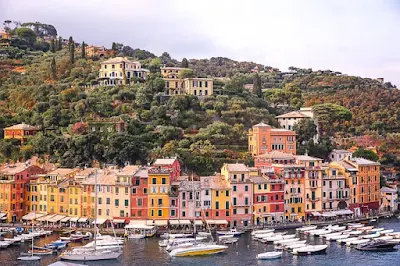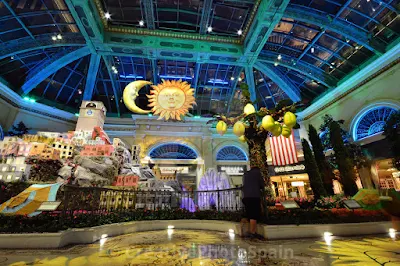Portofino is an Italian fishing village and holiday resort famous for its picturesque harbour and historical association with celebrity and artistic visitors. It is a comune located in the Metropolitan City of Genoa on the Italian Riviera. The town is clustered around its small harbour, and is known for the colourfully painted buildings that line the shore.
Pliny the Elder (AD 23 – AD 79) referred to Portus Delphini (Port of the Dolphin) as on the Ligurian coast between Genoa and the Gulf of Tigullio. The village is mentioned in a diploma from 986 by Adelaide of Italy, which assigned it to the nearby Abbey of San Fruttuoso di Capodimonte. In 1171, together with the neighboring Santa Margherita Ligure, it was included in Rapallo's commune jurisdiction. After 1229 it was part of the Republic of Genoa. The town's natural harbour supported a fleet of fishing boats, but was somewhat too cramped to provide more than a temporary safe haven for the growing merchant marine of the Republic of Genoa.
In 1409 Portofino was sold to the Republic of Florence by Charles VI of France, but when the latter was ousted from Genoa the Florentines gave it back. In the 15th century it was a fief of families such as the Fieschi, Spinola, Adorno, and Doria.
In 1815 it became part of the Kingdom of Sardinia and, from 1861, of the unified Kingdom of Italy. In the late 19th century, first British, then other Northern European aristocratic tourists began to visit Portofino, which they reached by horse and cart from Santa Margherita Ligure. Aubrey Herbert and Elizabeth von Arnim were amongst the more famous English people to make the area fashionable. Eventually, more expatriates built expensive vacation houses, and by 1950 tourism had replaced fishing as the town's chief industry, and the waterfront was a continuous ring of restaurants and cafés.
In 1409 Portofino was sold to the Republic of Florence by Charles VI of France, but when the latter was ousted from Genoa the Florentines gave it back. In the 15th century it was a fief of families such as the Fieschi, Spinola, Adorno, and Doria.
In 1815 it became part of the Kingdom of Sardinia and, from 1861, of the unified Kingdom of Italy. In the late 19th century, first British, then other Northern European aristocratic tourists began to visit Portofino, which they reached by horse and cart from Santa Margherita Ligure. Aubrey Herbert and Elizabeth von Arnim were amongst the more famous English people to make the area fashionable. Eventually, more expatriates built expensive vacation houses, and by 1950 tourism had replaced fishing as the town's chief industry, and the waterfront was a continuous ring of restaurants and cafés.
Main sights:
- Statue of Christ of the Abyss, placed underwater on 29 August 1954 in the inlet at a depth of 17 meters (56 ft). This statue was placed to protect fishermen and scuba divers and in memory of Dario Gonzatti, the first Italian to use SCUBA gear, who died in 1947. Sculpted by Guido Galletti, it represents Christ in the act of blessing while looking up towards the sky with open arms in a sign of peace.
- Castello Brown (16th century).
- Church of St. Martin (Divo Martino, 12th century).
- Church of St. George, housing some saints' relics.
- Oratory of Santa Maria Assunta, in Gothic style.
- King Richard I of England (1157-1199), in 1190
- Pope Gregory XI (1330-1378), in 1377
- Henry Herbert (1831-1890), British Politician
- Guy de Maupassant (1850-1893), French writer
- Guglielmo Marconi (1874-1937), Italian engineer, inventor of radio
- Giuseppe Amisani (1879-1941), Italian painter
- Michele Cascella (1892-1989), Italian painter
- Rex Harrison (1908-1990), English actor
- Lilli Palmer (1914-1986), German actress, wife of Rex Harrison
From June to September, visitors who want to sunbathe and relax in one of Italy’s most charming places flock to Portofino. The tranquil harbor is filled with gleaming sailboats and larger luxury vessels. The shore is lined with rows of quaint fisherman houses that vary in cheerful pastel colors and stylish bars and cafes. Sailing, diving, hiking, and exploring the coastline, which is filled with exquisite beaches and enchanting villages, are favorite pastimes. Hikers and birdwatchers delight in the immense natural diversity found in the area’s nature reserve, ‘Parco Naturale Regionale di Portofino.’ The vibrantly green and protected Regional Natural Park of Portofino is full of indigenous trees, plants, and animals, hiking trails, and incredible views of the gorgeous gulf and blue sea below.

























































